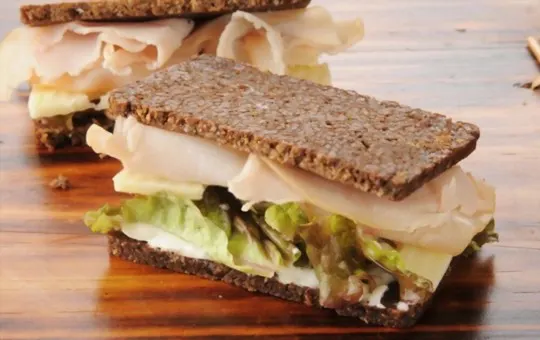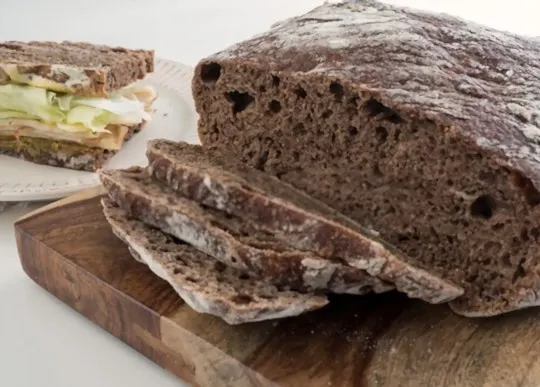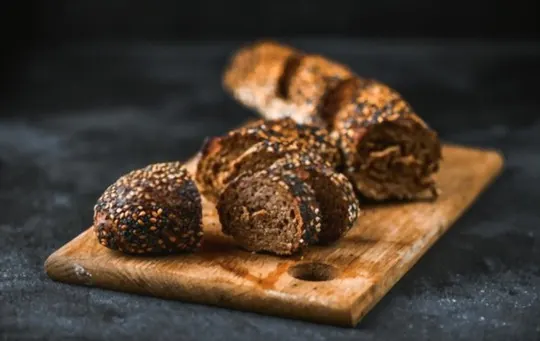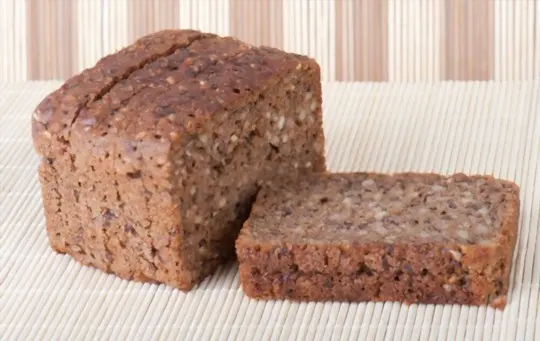Do you often find yourself wondering what pumpernickel tastes like?
Are you curious about the smoky, earthy flavor that this type of bread brings to your plate?
We’re here to provide all the answers!
In our comprehensive guide, we’ll go in-depth into what distinguishes pumpernickel from other types of bread and explain how its taste can make or break a dish.
From its origins to flavor profiles to tips for cooking at home, this is one bread you don’t want miss out on understanding. Let’s dive in!
What is Pumpernickel?

Have you ever wondered what pumpernickel is? A type of dense, dark rye bread originating in Germany, it has been a favorite among Europeans for centuries and is gaining popularity in the culinary world as more people hunt and appreciate artisanal foods.
Pumpernickel has a decidedly different texture than the usual white or wheat breads and gains its distinctive flavor from either molasses or cocoa.
It typically doesn’t contain sugar and due to it not rising as much of other breads, has a denser texture and chewy chewiness.
Its earthy nuttiness adds depth to sandwiches, soups and salads, providing a unique burst of flavor that complements the accompanying ingredients.
Pumpernickel can also be toasted with butter or turned into croutons for added crunch on salads.
Try some pumpernickel for your next meal to enjoy something truly unique.
What Does Pumpernickel Taste Like?

Pumpernickel bread has a unique, distinctive taste that sets it apart from other bread varieties.
The flavor and texture of Pumpernickel are influenced by its ingredients and the way it’s prepared.
Here are a few characteristics that contribute to Pumpernickel’s taste:
- Rye flour: Pumpernickel is made from coarse rye flour, which gives it a dense texture and a distinct, earthy flavor.
- Sour starter: Pumpernickel bread dough is often made with sourdough starter, which gives it a slightly tangy, sour taste.
- Molasses: Some recipes call for molasses, which adds sweetness and depth to the bread’s flavor.
- Caraway seeds: Pumpernickel bread is often seasoned with caraway seeds, which have a nutty, anise-like flavor and give the bread a mildly sweet taste.
These unique flavor combinations give Pumpernickel bread a rich, earthy taste with a slightly sweet aftertaste.
It’s often described as being slightly bitter, slightly sweet, and slightly sour all at once.
Its dense texture also adds to its overall flavor profile.
Pro tip: Pumpernickel bread tastes great when paired with hearty foods like stews, sausages, and smoked meats.
It also pairs well with tangy and sharp flavors like pickles and mustard.
Ingredients that Affect the Taste of Pumpernickel

Pumpernickel bread has a unique flavor profile that is the result of a combination of ingredients and baking process that sets it apart from other bread types.
Here are the ingredients that play a significant role in defining the taste of pumpernickel bread.
- Whole Rye Flour: Unlike other bread types that use mostly wheat flour, Pumpernickel bread is made from 100% whole rye flour. This gives the bread its characteristic dense, chewy texture and a distinct nutty taste.
- Caraway Seed: Pumpernickel bread is usually garnished with caraway seed that gives it a nutty and slightly sweet flavor.
- Molasses: Molasses is an important ingredient in pumpernickel bread that adds a deep brown color and a sweet flavor to the loaf.
- Yeast and cornmeal: Some recipes use yeast and cornmeal for added texture and flavor.
- Cocoa Powder and Coffee: Some recipes include unsweetened cocoa powder and coffee to give the bread a slightly bitter, chocolatey flavor.
As the ingredients listed above affect the taste of Pumpernickel, the bread’s baking process also influences its taste.
To make it soft and tender, it is baked at a low temperature for an extended period, typically for 24 hours or more.
1 – Rye Flour
Rye flour is a key ingredient in making pumpernickel bread, which has a distinct taste and texture.
Pumpernickel bread is dense, moist, and chewy with a strong, slightly sweet, and tangy flavor.
It is made using a sourdough starter and dark rye flour, often mixed with wheat flour or whole grain wheat berries.
The flavor of pumpernickel bread is enhanced by the addition of seeds, such as caraway, fennel, and anise.
Some recipes use molasses, cocoa powder, or espresso to deepen the color and add a slightly sweet and bitter flavor.
Pumpernickel bread has a long shelf life and can be stored for several days without becoming stale.
It is often used in traditional German dishes like sauerbraten and as a base for open-faced sandwiches with toppings like smoked salmon, cream cheese, and cucumber.
2 – Sour Starter or Yeast
Pumpernickel bread has a unique sour and earthy flavor thanks to its key ingredient, sourdough starter or yeast.
- Sourdough Starter: Pumpernickel bread made with a sourdough starter has a tangy and sour taste due to the natural fermentation of the dough. The fermentation process also results in a dense and chewy texture, making it ideal for sandwiches or toasts.
- Yeast: Pumpernickel bread made with yeast has a milder taste and a softer texture. The bread is usually lighter and fluffier than sourdough pumpernickel bread. This variety is more commonly found in grocery stores and bakeries.
- Additional flavorings: Some pumpernickel bread recipes may also include additional flavorings, such as molasses, coffee, or cocoa powder, which can give the bread a sweeter taste and a darker color.
Whether made with sourdough starter or yeast, the flavor of pumpernickel bread pairs well with savory ingredients like smoked salmon, pickled vegetables, and cream cheese.
It can also be used in sweet applications, such as bread pudding or French toast.
For a more pronounced sourdough flavor, let the dough ferment for a longer period.
This will also increase the density and chewiness of the bread.
3 – Molasses or Brown Sugar
Molasses or brown sugar is a key ingredient that gives pumpernickel bread its distinct flavor.
Pumpernickel bread is known for its rich and earthy taste, chewy texture, and dark brown color.
This type of bread gets its flavor primarily from the use of rye flour and the addition of molasses or brown sugar to the dough during the baking process.
The molasses or brown sugar provides a subtle sweetness and a pleasant caramel-like taste to the bread, while the rye flour adds a mild sourness and a nutty flavor profile.
Pumpernickel bread is also denser and heavier than standard bread due to its use of whole rye grains and a long baking time.
It is commonly used in making sandwiches, especially with meat and cheese, and also pairs well with soups and stews.
So, if you’re a fan of rich and hearty flavors, pumpernickel bread is definitely worth trying.
Its unique taste and texture make it a delicious and filling addition to any meal.
4 – Caraway Seeds
Caraway seeds are an essential flavor component in pumpernickel bread, contributing to its distinct taste and aroma.
Pumpernickel bread is a dense, dark bread made from coarse rye flour and sourdough starter.
Its flavor is earthy, slightly sweet, and mildly sour, with hints of molasses and cocoa powder.
Caraway seeds add a warm, slightly bitter flavor to the bread, enhancing its overall taste.
Here are some additional flavor notes about pumpernickel bread:
- It has a chewy texture and a moist crumb.
- Toasting the bread brings out its nutty flavor and crispy crust.
- Pumpernickel pairs well with savory toppings like smoked salmon, cheese, and pickles, as well as sweet toppings like jam and honey.
- The bread has a long shelf life and can be stored at room temperature.
- Pumpernickel bread is a good source of fiber, protein, and vitamins B and E.
Pro tip: To make your pumpernickel bread even more flavorful, try adding other ingredients like dried fruits, nuts, or seeds.
Different Varieties of Pumpernickel
Pumpernickel is a dense and hearty bread made from rye flour that has a distinct taste and texture.
The specific taste of pumpernickel can vary depending on the variety, ingredients, and baking process used.
Here are some different varieties of pumpernickel and their taste profiles:
- German-style pumpernickel: This variety is made from coarsely ground rye flour or rye meal, and often includes molasses, sourdough starter or yeast, and spices like caraway seeds. German pumpernickel is dark brown or nearly black, with a moist and chewy texture and a mildly sweet, earthy flavor with hints of sourness.
- American-style pumpernickel: This variety typically uses a blend of rye and wheat flour, with added molasses or caramel coloring to achieve the darker color. American pumpernickel is milder and sweeter than the German version, with a softer texture that may include chopped nuts or raisins.
- Swedish-style pumpernickel: This variety is made from a mixture of rye and wheat flour, often with the addition of honey or brown sugar, and is baked until crispy. Swedish pumpernickel has a crunchy texture and a sweet, nutty flavor.
Regardless of the variety, pumpernickel is a nutritious and filling bread, packed with fiber and flavor.
It pairs well with hearty soups and stews, or can be served with sliced meats and cheeses for a hearty sandwich.
Pro tip: Store pumpernickel in a resealable plastic bag in the refrigerator to keep it fresh for up to a week.
How to Enjoy Pumpernickel?

Pumpernickel bread has a unique flavor profile that is often described as earthy, robust, and slightly sweet with subtle notes of molasses and cocoa.
Its texture is dense, chewy, and moist, making it perfect for sandwiches and toasts.
Pumpernickel bread is also rich in fiber and essential nutrients, such as vitamins B and E, iron, and potassium.
To enjoy pumpernickel bread, try pairing it with savory toppings like smoked salmon, cream cheese, cured meats, or pickles.
You can also use it to make croutons, breadcrumbs, or stuffing.
Pumpernickel flour can be used in hearty bread recipes, such as rye bread or sourdough bread, for added flavor and texture.
Is Pumpernickel Healthy?

Pumpernickel bread is a wholesome and nutritious food that offers plenty of health benefits, but it may not be everyone’s favorite due to its distinct flavor profile.
Pumpernickel bread is made from whole grain rye flour and has a dense texture and a deep, robust flavor.
Its taste is often described as earthy, nutty, and slightly sweet, with notes of sourdough and molasses.
Some people enjoy pumpernickel bread on its own, while others prefer to toast it or use it as a base for sandwiches and spreads.
Nutritionally, pumpernickel bread is an excellent source of fiber and contains essential vitamins and minerals, including iron, magnesium, and calcium.
It has a lower glycemic index than white bread, meaning it causes a slower and steadier rise in blood sugar levels, making it a more suitable option for those with diabetes or insulin resistance.
Additionally, the phytonutrients found in whole grain rye flour have been linked to a reduced risk of cancer, heart disease, and digestive disorders.
While pumpernickel bread is a nutritious and wholesome food, its flavor may not be for everyone.
However, it can be a great addition to a healthy and balanced diet, especially when paired with other nutrient-dense foods like vegetables, lean protein, and healthy fats.
If you’re new to pumpernickel bread, try pairing it with flavorful spreads like hummus or avocado, or toast it and add a dollop of almond butter or honey for a satisfying snack.
Where to Buy Pumpernickel and How to Store It?
Pumpernickel bread has a unique taste and texture, making it a popular choice for those who want to add variety to their bread selection.
Pumpernickel bread has a nutty, earthy flavor and is typically denser and moister than other types of bread.
The bread is made from rye flour, which gives it a distinctive taste and texture.
If you’re looking to buy pumpernickel bread, you can find it at most grocery stores and bakeries.
Look for a moist, dense loaf with a dark brown color.
When storing pumpernickel bread, wrap it tightly in plastic wrap or foil and keep it at room temperature for up to 5 days.
You can also freeze pumpernickel bread for up to 3 months.
Conclusion
In conclusion, pumpernickel bread has a unique flavor that sets it apart from other bread varieties.
Its earthy and slightly sweet taste comes from a combination of sourdough starter and rye flour, along with the long baking time at a low temperature.
Pumpernickel bread has a dense texture and a moist crumb, making it an excellent base for sandwiches and toast.
It pairs well with savory flavors like smoked salmon and cream cheese or sweet toppings like honey and nut butter.
If you’re looking to try a new type of bread, give pumpernickel a chance and explore the possibilities of its robust flavor.

What Does Pumpernickel Taste Like? A Comprehensive Guide
Ingredients
- Pumpernickel
- Ingredients from your selected recipes
Instructions
- Select your favorite ingredient from the range available in this article.
- Collect all the necessary items to make the recipe.
- Use the instructions provided to prepare a delicious dish in 30 minutes or less.

Carrie is a food writer and editor with more than 15 years of experience. She has worked for some of the biggest names in the food industry, including Bon Appétit, Food & Wine, and Martha Stewart Living.
As the Editor in Chief of IntroChicago.com, Carrie oversees all of the content on the site. She also manages the team of contributing writers and editors, who help to create delicious recipes, helpful tips, and informative articles that you’ll find on the site.
A native of the Chicago area, Carrie is passionate about all things food. She loves trying new restaurants and experimenting with new recipes in her kitchen. She’s also a graduate of the Culinary Institute of America, so she knows a thing or two about food!
